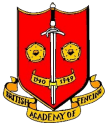The British Academy of Fencing is an organisation for fencing coaches in Great Britain and Northern Ireland.
The origins of the Academy lie in the sixteenth century Company of the Masters of Defence of London. This was the recognised guild for the teaching of fencing in and around London. It was made up of Free Scholars, Provosts and Masters — all of whom had to achieve their status by “playing their prizes” and taking the appropriate oaths. This “Playing of Prizes” consisted of challenging one’s betters to combat in a theatre before an audience . The Company was headed by a group of four “Ancient Masters” who ran the business of the guild.
Like other guilds, the Company of the Masters of Defence concerned itself with protecting the interests of its members. It took care of the welfare of Masters who had fallen on hard times or had left widows and orphans, and it regulated the profession, for example, by making rules about the conduct of fencing schools and the setting of fees. It also sought to protect its members against outside competition, from unqualified fencing teachers and especially from the Italian fencing masters who were popular at the time.
The Company was issued its Warrant by Henry VIII in 1540, which granted it a monopoly over the teaching of fencing in England and gave the Company the power to commit to gaol anyone who undertook to teach fencing without being a member of the Company.
This monopoly lapsed on
the death of Henry VIII in 1547. It was briefly recovered under the
reign of James I, who granted them a Warrant in 1605 . but was abolished
when James was forced to pass the Monopolies Act . The Company
eventually fell into disrepute due to the number of swordsmen who gave
themselves the title of “Master” or “Professor” without having “Played
their Prizes”. Such “Masters” amounted to little more than paid
prizefighters and had little respect.
There were some attempts in the
early 20th century to reform the guild, first in 1903, under the title
“The London Académie d’Armes”, and again in 1931 as “The British
Federation of Fencing Masters”.
All this was interrupted by the
Second World War. In 1949 an Ancient Guild of Fencing Masters was again
refounded as “The British Academy of Fencing”. The inspiration for this
venture came from the late Charles de Beaumont and it was implemented by
Professor Roger Crosnier, Professor Leon Paul and Mr. J.D. Aylward. The
Academy’s first President was Professor Leon Bertrand.
The British
Academy of Fencing (B.A.F.) is a founder member of the Academie d’Armes
Internationale – the international federation of fencing academies.
The Academy of today is a progressive organisation and changes are constantly taking place. By the maintenance of a carefully structured system of courses and examinations, the Academy provides teachers and/or coaches of fencing with the opportunities to qualify through Level 1, Level 2, Level 3 and Advanced Awards, with Foil, Epee and Sabre up to Diploma standard. The B.A.F. Diploma is recognised and respected throughout the world and is the qualification required for full status in the Academy.
